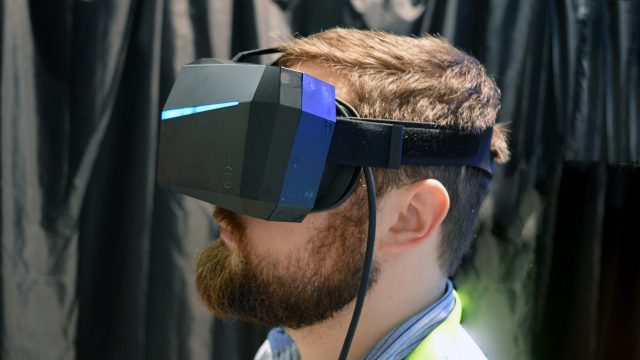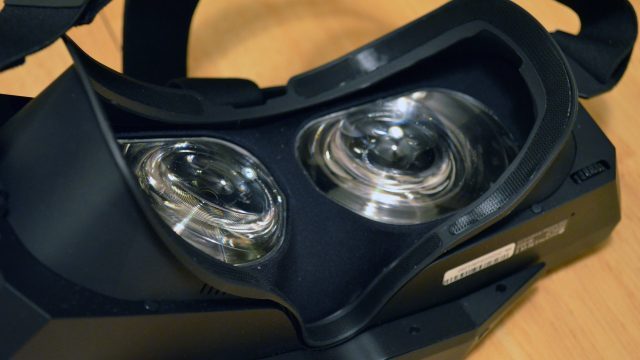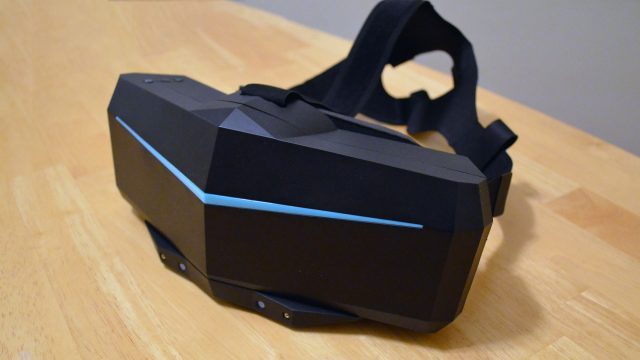Last year at CES we took a good long look at Pimax’s “8K” headset and saw potential, but identified a number of key issues that would need addressing before the headsets actually hit the market. This year at CES, our hands-on with Pimax’s latest headsets shows that they’ve made big progress and addressed most of the major issues seen last year.
It took a few delays over the course of 2018, but Pimax has made big steps forward with their “8K” headset, and even announced a new variant (the “5K” Plus, which replaces the former “5K” with an improved display). Now the company has begun delivering headsets to Kickstarter backers, taking open orders, and is on the cusp of shipping to its first non-Kickstarter backers.


Last year I concluded that, despite the issues, “there doesn’t seem to be any unproven hurdles in their way, but it’s going to take careful execution to get there.”
After going hands-on with the production version of the Pimax “8K” and “5K” Plus this week at CES 2019, I came away impressed with the progress the company has made toward delivering a headset with an ultrawide FOV that can stand as a real option next to contemporary headsets.
It seems prudent to go through each of the issues identified last year and give a brief assessment of where things are today.


Last Year: Several distracting visual artifacts are hampering the experience.
Last year the Pimax headset was showing bothersome artifacts at the edges of the wide FOV, including blur, distortions, and distracting reflection-like imagery at the top and bottom. There was also eyestrain that I couldn’t quite place, but felt like the headset was making it challenging for my eyes to maintain stereo fusion, which suggests some sort of projection or alignment issue.
This Year: Most of the prior visual artifacts have been eliminated.
This year when looking into the headset’s ultrawide FOV I saw an image that was impressively wide and mostly consistent across the field of view. The distracting reflection-like imagery at the top and bottom of the image are completely gone, and so is the heavy blur in the periphery. The far left and right periphery still show some distortion of the image, but it’s fairly minimal; how distracting that distortion is will depend on content (and probably also your facial topography), though if it looks to others as it does to my eyes, I think it’s subtle enough that most people will be able to get used to it without much bother.
If you can’t get used to it, Pimax offers three software field of view settings which reigns in the FOV, with the distorted regions mostly not seen at all with the middle ‘Normal’ setting. There’s also other reasons you might want to run at a setting other than the maximum FOV (like less demanding rendering).
The lingering eye strain I felt last year seems to be eliminated. And while previously the IPD adjustment didn’t show you an actual measurement in the headset (which might have contributed to the issue), that information now appears correctly in the view, making it easy to dial in your known IPD.
Last Year: Pimax claims total elimination of the screen door effect.
Last year Pimax was advertising for the “8K” that “the graininess and ‘screen door’ will never disturb you again.” That sounds undoubtedly like the screen door has been eliminated on the headset, but it wasn’t the case at CES. While the screen door effect is reduced over other headsets it was by no means eliminated.
This Year: Screen door claims are still not true.
Pimax is still making misleading claims about the “8K” not showing any screen door effect (“Get rid of the SDE”), and even for the lower resolution “5K” Plus (“no more pain about Screen Door Effect”). I’ve seen prototype VR displays which actually have zero visible screen door effect, but this is not true for either Pimax headset. The screen door effect is less visible than first-gen headsets like the Rift or Vive, but certainly doesn’t come close to eliminating it outright. This seems to be mostly a case of exaggerated marketing, but they should really admit their exaggeration and dial it back.
Last Year: Strange green lines across the display.
Last year Pimax was still getting its screens finalized and tuned for its headset. Mura is a ‘cloudy’ effect seen on the display caused by inconsistencies in color accuracy and brightness between pixels. While that’s expected to some extent on all headsets (some worse than others), in the Pimax “8K” last year headset I saw an unmistakable mura-like artifact: faint but unmistakable rows of green lines crossing the displays which hurt the overall clarity of the image. I’m not sure what the exact cause was.
This Year: The lines are totally eliminated.
Checking out both the “8K” and the “5K” Plus, neither had the lines that I had seen previously. The usual mura is still there, perhaps a bit improved, and appears now to be on par with contemporary headsets.
Last Year: Unacceptably high rotational latency and choppy positional tracking.
Though the Pimax headsets use SteamVR Tracking, (known to be capable of precise, low latency tracking) I said last year that Pimax’s implementation was “a mess,” and that the company had yet to master the tech. Rotational tracking had far too much latency and positional tracking was jumpy.
This Year: Vastly improved tracking performance, with some lingering latency on the “8K” but not the “5K Plus”.
This year Pimax has shown a massive improvement in tracking performance, consistency, and latency. The company seems to have really wrapped its head around SteamVR Tracking. Positionally, the headsets now feel just as good as you’d expect when wearing a Vive. On the “5K” Plus, rotation also feels great, culminating in a well tracked headset that feels on par with any other out there.
The “8K” however clearly has some additional rotational tracking latency compared to the “5K” Plus (it might also be the case with positional latency, but that’s harder to visually identify under a certain threshold). It’s not a huge amount, low enough that those who don’t use VR on a regular basis might not immediately notice, but I think it’s enough that it could lead to issues in comfort over time.
I told Pimax about the latency issue and asked them what it might be—a bug? an inherent issue?—they seemed to not be familiar with the issue, though I confirmed my observations on two separate headsets and with some other folks who have spent a lot of time with the “8K”. I’m trying to get to the bottom of this, but it sounds like it will take some investigation by Pimax.
The company was also showing their headsets used with both Vive wands and the upcoming Pimax controllers. Both seemed to track very well; I’ll talk more about my time with the Pimax controller in a future article.
Last Year: The soft strap and size of headset could pose long-term comfort challenges.
The industry has largely moved away from soft straps since development kits and early consumer headsets; rigid straps with some balancing weight have been favored as more comfortable options. Pimax is still relying on a soft strap and a bring-you-own-headphones approach to audio. They promised a hard strap (and a version with headphones built in) but haven’t shown it in action.
This Year: The company is still promising a hard strap but still hasn’t shown a prototype, and is about to begin open-order shipping with the soft strap.
Now a year later, headphones with soft straps and no headphones feel even more dated. The convenience of not needing to fuss with yet another thing to plug in and put on your head (the headphones) actually makes a pretty big difference to the friction of using VR, and it’s something you don’t want to go back to after using a headset with integrated audio.
The Pimax headsets are indeed lighter than they look, and their footprint doesn’t actually feel unreasonably larger than contemporary headsets. The soft strap isn’t ideal for comfort, but after spending even more time in the headsets it doesn’t seem like a dealbreaker by any means (of course this may vary depending upon the shape of your head and face). That said, it’ll be a nice upgrade once Pimax gets their hard strap out the door; it’s a shame that customers won’t have it out of the box.
– – — – –
The headsets aren’t without some flaws, but the improvements Pimax has made are elevating it from an ambitious startup making big promises to a company that can put together noteable hardware. It’s taken some delays to get here—and there’s still a few missing pieces for the full headset package—but Pimax is forging ahead.

